Fail fast, but gracefully was the theme of the 17th annual itSMF Czech Republic conference.
My session at the conference was titled “Fail frequently, but consistently,” in which I revealed the findings of The Shiny New Thing that Really Helps global mini-survey and what it says about the key ITSM challenges.
The award-winning Shiny New Thing that Really Helps was the theme of my 2022 European tour, in which I presented five key challenges facing organizations. Five key challenges that have caused us to fail with each new best practice framework adoption – failing frequently as it were, and consistently – each time in respect of these key areas.
Here @GamingPaul shares survey data that highlights the many reasons why IT transformation initiatives fail. #ITSM #Leadership Click To TweetIn my The Shiny New Thing that Really Helps tour, I presented the “70% stormy depression club card,” revealing that 70% of transformation initiatives fail to deliver the expected outcomes, and 70% of organizations score consistently low in these five areas, or ITSM challenges, according to various industry reports. (This article, The State of the Union, describes the five key areas and contains links to the industry findings).
I asked delegates in my European tour sessions to raise their hands if they were proud club members! A shocking majority raised their hands!
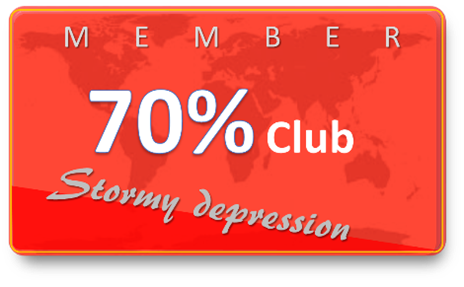
To confirm this worrying feedback with a broader audience, I conducted a mini-survey about ITSM challenges and opened this up to the global IT service management (ITSM) community.
Are our capabilities really still so poor? Or are people just afraid to raise their hands? Are they intimidated by my pointy-fingered grumpiness? This is what I wanted to confirm or dispel.
This article reveals the findings of this global survey. The countries responding can be found at the end of this article.
The five key challenge areas are:
- Strategic fit
- Leadership
- Skills
- Culture
- Continual learning and improvement
Two to four questions were asked in each of these five areas.
In this article @GamingPaul shares global survey data related to the quality of IT leadership, skills, culture, and continual improvement. Read it here. #ITSM #Leadership Click To TweetIt’s Groundhog Day again (for ITSM challenges) …
Groundhog Day is a film starring Bill Murray, in which he wakes up every day to relive exactly the same situations again and again… and again. That is how I feel when I look at the five key challenges mentioned above AND these global survey results.
Every year I wake up to the same industry failings!
The table below shows the top-scoring ABC (Attitude, Behavior, Culture) worst practice cards chosen in workshops by organizations around the world 20 years ago (and have been consistently high scorers every year since!). The table also shows the relationship with the five key ITSM challenge areas that we now struggle with according to my analysis of industry findings.
| Top ABC cards (+20 years) | Challenge areas |
|---|---|
| 1 – IT has too little understanding of business impact and priority | 1 – Strategic Fit |
| 2 – No management commitment | 2 – Leadership |
| 3 – Them & Us culture; throwing solutions over the wall | 3 – Culture |
| 4 – ITIL is the objective, not what we want to achieve with it | 4 – Skills |
| 5 – Plan, Do, Stop… No real continual improvement culture | 5 – Continual Improvement |
As I said, it’s Groundhog Day! Surely the global survey results will paint a more optimistic picture?
Shiny New Thing that Really Helps Survey
Each question in the survey can be scored from 1 to 6:

Strategic Fit
These were the four ITSM challenges questions I asked relating to Strategic Fit.
- Strategic goals are always known and are cascaded top-down and left to right through the organization to drive decision-making and prioritization mechanisms.
- We measure the outcomes achieved (in relation to strategic goals) from all IT investments and initiatives.
- We have formalized governance mechanisms (e.g. COBIT, ISO38000) that ensure decision-making and priority mechanisms help deal with conflicting business priorities and demands.
- Our governance mechanisms ensure that our portfolio of IT initiatives is balanced between innovation, risk, and improvement work.
The results below show the percentage of respondents scoring a 1, 2, or 3 for each of the four questions above:

My findings related to the four questions above:
- In my global simulation workshops in the last ten years, delegates rarely know their organization’s strategic goals nor how their work contributes to or hinders these goals. 69% score this as low in the survey. I often see that strategic goals are cascaded to a management level and are unknown or unclear to people carrying out the work. They are usually not embedded into decision-making and prioritization mechanisms end-to-end throughout value chains. Often specific siloes have their own conflicting silo-related goals and priority mechanisms.
- The low score on measuring outcomes was no surprise to me. 80% scored this low. We have discussed value and outcomes for over 20 years but measure output and throughput metrics rather than outcome metrics. Partly this can be attributed to Strategic Fit, question 1 – the fact that strategic goals are not always known.
- With the explosive demand for IT from all business areas, there are always conflicting goals and demands requiring effective governance mechanisms. 80% scored this low. Without effective governance mechanisms, “Who shouts loudest” often gets the IT resources and funding. Usually, this is for innovation and renewal work at the expense of technical debt and improvement work. This represents a significant risk to achieving the hoped-for outcomes.
- Because we fail to measure outcomes, it’s difficult to show the effects of ignoring technical debt and improvement work. This type of work is often invisible and not included in portfolio planning and decision-making. 79% scored this balance of different types of work as low. Strategic Fit, question 3, relating to effective governance mechanisms, compounds this.
The survey clearly reveals that the majority of organizations are proud members of the 70% stormy depression club as far as Strategic Fit is concerned. If your organization is one of them, print and cut out the 70% stormy depression club card and pin it up on every notice board in your organization. When people ask what it is, you can tell them! Ask them what should be done about it, and add their suggestions to the continual learning and improving backlog.
Oh no. Wait! First, look at the scores for the Continual Improvement challenge area.
Leadership
These were the two ITSM challenges questions asked relating to Leadership:
- We have leadership development programs in place to develop skills needed to manage culture and behavior change.
- Managers are committed to the behavior and culture change by creating safety, fostering feedback, and ensuring time is reserved for teams to learn and improve.
The results below show the percentage of respondents scoring a 1, 2, or 3 for each of the questions above:
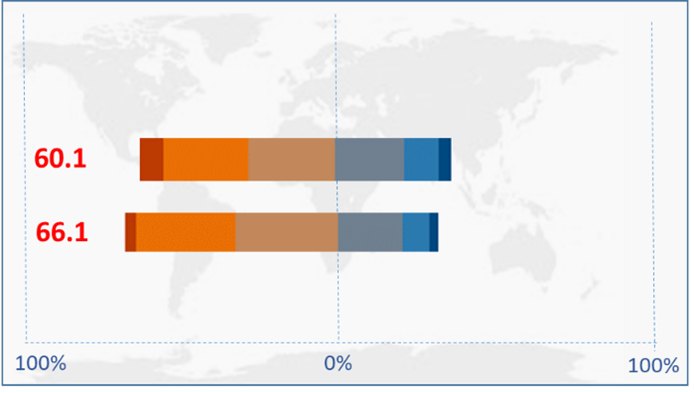
Findings:
- Many organizations are embarking on digital and agile transformations, which require a culture change (collaborative, open, safe, transparent, focus on continual learning and improving, and focus on customer value). Leaders, however, are poorly equipped to manage this type of cultural transformation. Industry reports reveal that 70% say they struggle with culture change, yet more than 60% scored Leadership development as low. Is it any wonder many struggle?
- Managers must be committed to changing behavior to support and enable the new culture. Most managers say they are committed, but what behaviors demonstrate commitment? This is often unclear. 66% scored low on commitment. This may have something to do with a lack of appropriate skills to bring about cultural and behavioral change. The low score in Skills, question 1 also contributes to sub-optimal results from training investments (lack of a formal approach to embedding new skills and behavior into the organization).
The good news is that the survey reveals that this area doesn’t fit with the 70% club (sound of loud clapping). However, for +60% of organizations, leadership capabilities represent a risk to successful transformation (sound of muted mumbling).
For over 60% of organizations, leadership capabilities represent a risk to successful transformation, according to @GamingPaul's latest survey data. #ITSM #Leadership Click To TweetCulture
Two ITSM challenges questions were asked relating to Culture:
- We have defined and widely known corporate values and principles and have translated these into the behaviors that represent our new culture.
- We apply practice, coaching, and open feedback to help embed new behaviors into the organization.
The results below show the percentage of respondents scoring a 1, 2, or 3 for each of the questions above:
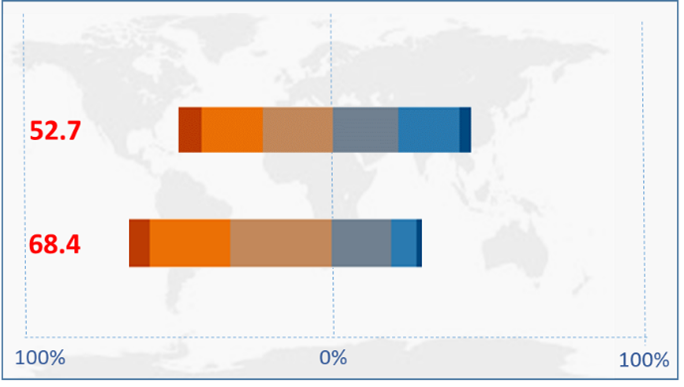
(The percentage of respondents scoring level 3 for question 1 should be higher. Follow-up investigations revealed that 40% of those scoring 4 amended it to a 3 when asked if they have given a 4 on ‘Widely known’ AND ‘Translated into behaviors’ instead of scoring 4 for just ‘Widely known’)
Findings:
- Only 52% score low on translating corporate values into behaviors. This confirms a growing recognition of, and focus on, culture change as part of agile transformation initiatives. However, what I often see is that corporate values are defined and communicated but are NOT translated into sustainable, desirable behaviors.
- To embed new behaviors into culture requires practice, feedback, and often coaching. 68% scored this low. Without this effort, it’s easy to revert to old behaviors, undermining the culture change ambitions. The low score on Leadership, questions 1 (development) and 2 (commitment) compounds this and raises concerns about the effectiveness of culture change initiatives.
I am delighted there is more focus on culture. We have always known it is all about culture. Yet we continue struggling with every adoption of shiny new frameworks. In my opinion, it isn’t about changing culture or mindsets. It is about changing Attitudes (mindsets) to create buy-in to desired, repeatable, sustained new ways of doing things (Behavior) that eventually become the way we do things around here (Culture). Leadership skills are a critical enabler, which we see still scores low, showing a lack of appropriate, effective effort.
Skills
These were the three ITSM challenges questions asked about skills:
- We have a formal approach to ensure that people know the goals, the problems we need to solve, and the expected behaviors we want to learn when they go on training.
- We have mechanisms in place to measure that new behaviors are being applied after a training course and that business outcomes are being impacted by applying these behaviors.
- With best practice framework training, we ensure end-to-end representation in training courses to help foster collaboration, break down silos, and create better understanding and buy-in.
The results below show the percentage of respondents scoring a 1, 2, or 3 for each of the questions above:
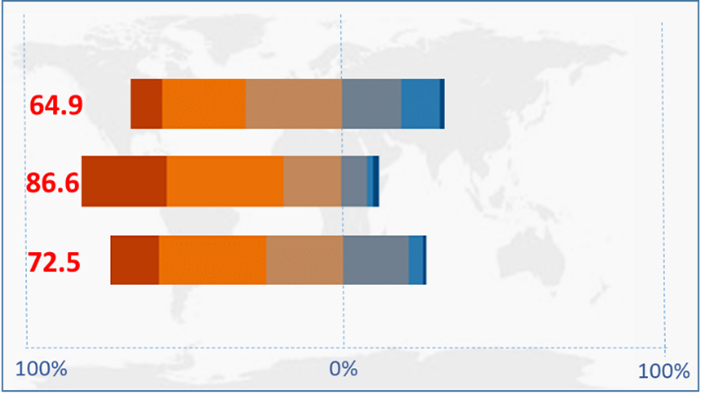
Findings:
- Almost 65% have no formal approach, such as the 8-Field model, to ensure that:
- Training is aligned to goals (The low score on Strategic Fit, question 1 compounds this)
- Mechanisms are in place to transfer learning into behaviors, such as practice, feedback, and coaching (Low scores on Leadership, question 2, and Culture, question 2 compound this)
- The impact of training is being measured and evaluated.
- A massive 86% have no mechanisms to measure the intended or actual impact of training investments, which is significantly higher than a Harvard Business Review survey in The State of The Union article mentioned above.
- Collaboration and end-to-end capabilities are important to realize agile transformation goals. 72% do not have end-to-end representation in training. Often siloes attend their own silo/framework-related training, which compounds the “them and us” culture. End-to-end representation helps create a shared understanding and shared recognition of end-to-end improvement opportunities. Here is an example of end-to-end representation in a business simulation workshop.
Continual Improvement
I asked these two ITSM challenges questions relating to Continual Improvement:
- Continual improvement is applied top-down and left to right through the organization and is seen as a strategic capability.
- Time is reserved for people to continually learn and improve and improvement suggestions are prioritized and followed up on.
The results below show the percentage of respondents scoring a 1, 2, or 3 for each of the questions above:
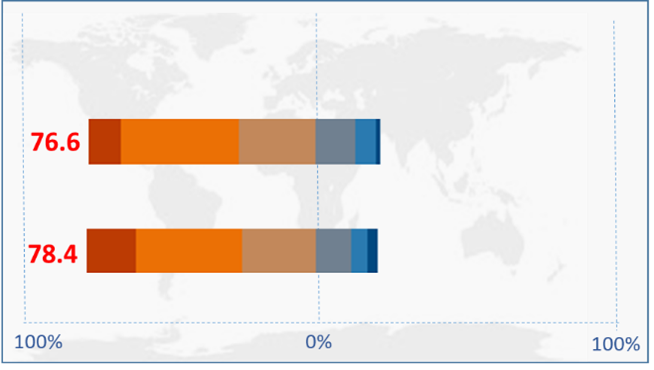
Findings:
- Continual Improvement was one of the weakest areas, as I had expected. 76% scored this as a low capability. What I see is that continual improvement is often localized and either process or department-focused with a lack of top-down and left-to-right focus. Continual Learning and Improvement is not seen as a strategic capability. The low scores on Strategic Fit, question 3 (governance mechanisms), and question 4 (balanced portfolio) compound this. Improvement work often gets bounced in favor of innovation work (with the lack of measuring the impact on outcomes compounding this).
- 78% gave a low score to reserving time and for following up on improvement needs. Partly due to poor Leadership skills (see the Leadership, question 1 score) and partly through lack of governance (see Strategic Fit, questions 3 and 4). Teams are pressured to fulfill conflicting business demands, and IT cannot justify how improvement impacts strategic outcomes as strategic goals are often not known (see Strategic Fit, question 1).
Overall Scores
The radar plot below shows the average scores for the 13 questions above. Surprisingly, the overall scores are predominantly Poor to Weak, with Culture scoring the highest as Weak to OK.
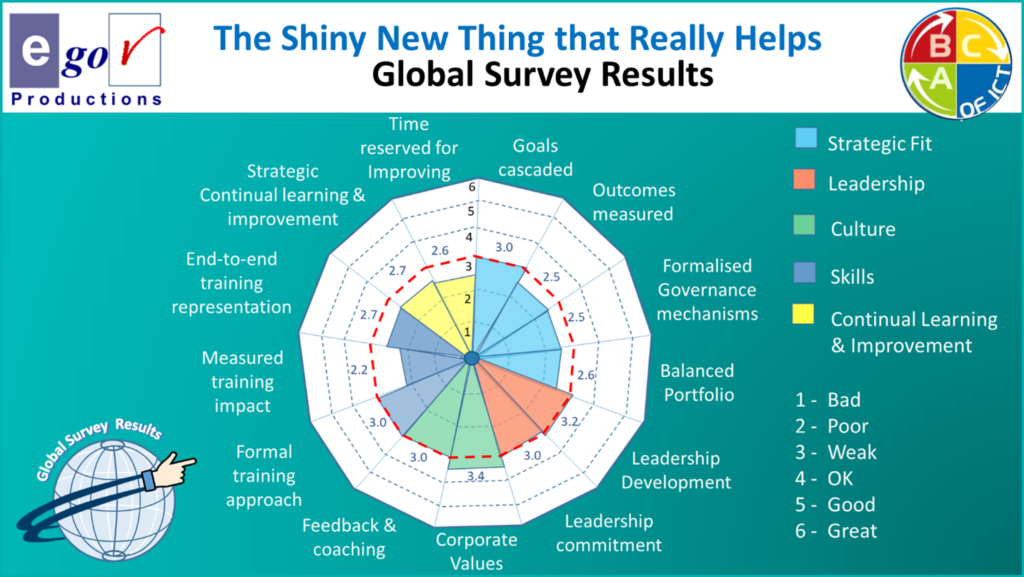
The scores in this survey and their relationship to 20 years of ABC workshops, in which the same worst practice cards are chosen year in and year out, explain in part the title of my presentation, “Fail frequently.” I see the same things happening with each shiny new framework we adopt. We hit the same five challenge areas, which explains the second part of my presentation title, “but consistently.”
The theme of the itSMF conference was “Fail fast, but gracefully.” I looked up the definition of the word gracefully: “in an attractively elegant way; in a respectful and dignified way.”
It may just be me, but I don’t see anything respectful in our frequent and consistent failure to adopt and apply frameworks to create new ways of behaving.
What next for these ITSM challenges?
What can you do to improve your capabilities in these five areas? I wrote a four-part article for itSMF Czech Republic following my ‘Shiny New Thing that Really Helps’ session in 2022. The article is titled “Groundhog Day: 40 years’ worth of “Oh No Not again!” It contains a number of tips.
After seeing the survey results, I recommend that if you are a member of the 70% stormy depression club, or an organization that scores 3 or lower in these areas, you look at the tips.
The link below is part one of the article. The links to the subsequent parts are at the end of each preceding article: https://itsmf.cz/groundhog-day-40-years-worth-of-oh-no-not-again-part-1/
And finally, I can only assume, by looking at the scores, that for the last 20 years, the industry has been applying the WRONG PDCA model. People have been using the “Continual IGNOREMENT Model” rather than the Continual Improvement Model. I can see no other logical explanation for the way we behave!
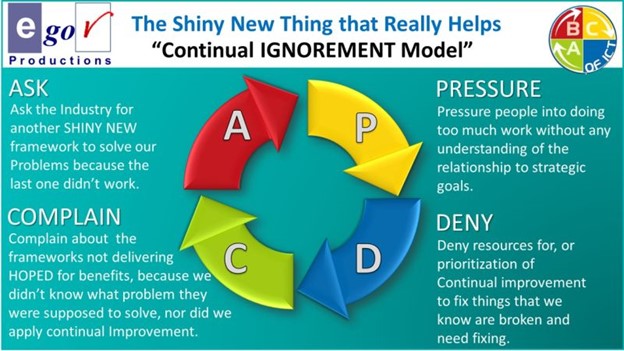
ITSM challenges survey participation
There were 180 respondents representing more than 300 organizations (a number of training and consulting organizations employees filled in the averages they see across their client base) in the following countries: Argentina, Australia, Austria, Belgium, Brazil, Bulgaria, Canada, China, Columbia, Czech Republic, Denmark, Ecuador, Estonia, Finland, France, Germany, Greece, India, Iran, Israel, Japan, Kazakhstan, Macedonia, Mexico, Netherlands, New Zealand, Norway, Poland, Russia, Singapore,
Slovakia, Sweden, South Africa, Spain, Switzerland, Thailand, UAE, UK, and USA.
If you liked this ITSM challenges article, the following ITSM articles might interest you.
Paul Wilkinson
Paul Wilkinson has been involved in the IT industry for more than 25 years and has a broad background in IT operations, IT management, and product innovation and development. He was project team lead in the original BITE (Business & IT Excellence) process modeling of ITIL, an ITIL V2 author, and member of the ITIL V3 advisory group.
He is co-owner of GamingWorks and co-developer of a range of business simulations focusing on IT service management, project management, business process management, business and IT alignment, alliance management and co-author and developer of the ABC of ICT products and publications.

